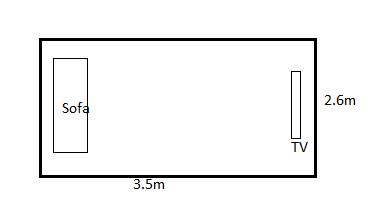Before I begin I know this might need to go in the electrics section but this isn't about how to wire lights up, it's about ideas for lighting.
I want to put in some dimmable led downlights so as to create a 'home cinema'. The area that this is going in is 3.5x2.6m (see image).
Has anyone got any recommendations on how many lights I should have i.e. rows and columns? These lights are purely for watching movies, I don't need to worry about using the lights for other tasks.
Also, I guess I don't want a light directly over the TV as it would cause glare, is there a distance I should have a light from the TV? Does the same go for the seating?
Thanks
Alex
I want to put in some dimmable led downlights so as to create a 'home cinema'. The area that this is going in is 3.5x2.6m (see image).
Has anyone got any recommendations on how many lights I should have i.e. rows and columns? These lights are purely for watching movies, I don't need to worry about using the lights for other tasks.
Also, I guess I don't want a light directly over the TV as it would cause glare, is there a distance I should have a light from the TV? Does the same go for the seating?
Thanks
Alex



